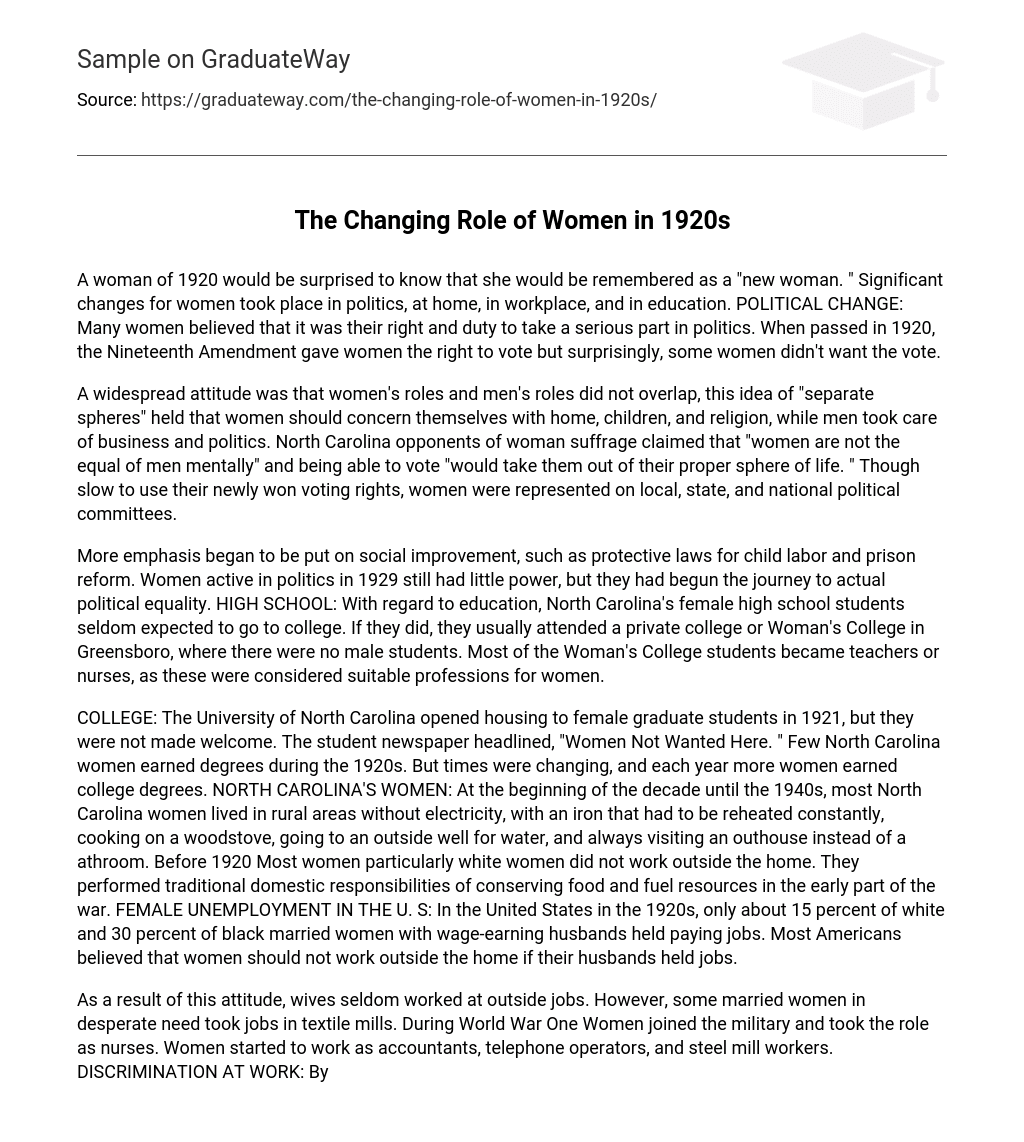Throughout the 1920s, women witnessed considerable transformations in different realms of their lives. These encompassed politics, home life, the workplace, and education. Notably, many women embraced the belief that they had both the right and duty to engage actively in political affairs. The ratification of the Nineteenth Amendment in 1920 conferred upon women the right to vote; nevertheless, it is astonishing that certain women did not aspire for this particular right.
The prevailing belief was that women and men had separate roles that did not intersect. This concept, referred to as the idea of “separate spheres,” proposed that women should concentrate on their homes, children, and religion, while men dealt with business and politics. Opponents of granting women’s suffrage in North Carolina contended that women were intellectually inferior to men and giving them the right to vote would disrupt their traditional lifestyle. Nonetheless, after being granted suffrage rights, women gradually began engaging in politics at various levels – local, state, and national.
There was a growing focus on social improvement, including laws to protect child laborers and reform prisons. Although women involved in politics in 1929 had limited power, they were starting to work towards achieving political equality. In terms of education, female high school students in North Carolina typically did not anticipate attending college. If they did pursue higher education, they usually attended a private college or Woman’s College in Greensboro, which only admitted female students. Many of these students at Woman’s College went on to become teachers or nurses, as these were deemed appropriate career choices for women.
In 1921, female graduate students at the University of North Carolina were permitted to reside in housing, despite facing resistance. The student newspaper boldly proclaimed, “Women Not Wanted Here.” Nevertheless, the number of women pursuing higher education increased annually throughout the 1920s.
From the 1920s to the 1940s, majority of women in North Carolina resided in rural areas where access to electricity was limited. They relied on woodstoves for cooking and had to fetch water from wells outside their homes. Having an outdoor bathroom was a necessity rather than having a conventional one indoors. Prior to 1920, particularly among white women, it was common for them not to engage in employment outside their households but instead focus on traditional domestic tasks and conservation efforts during times of war.
During the 1920s in the United States, only approximately 15 percent of married white women and approximately 30 percent of married black women with employed husbands held paying jobs. At that time, it was widely believed that if their husbands already had jobs, women should refrain from seeking employment beyond their homes.
Due to this mindset, wives rarely pursued employment outside of the home. Nevertheless, some married women who were in dire need resorted to taking positions in textile mills. In World War One, women entered the military and served as nurses. Additionally, women began working as accountants, telephone operators, and employees in steel mills. Concerning workplace discrimination, by 1922 North Carolina had become a prominent manufacturing state, prompting mills to hire female workers for labor on the factory floor. Furthermore, cotton mills also recruited nurses, teachers, and social workers to support social and educational initiatives.
Due to segregation, these mills did not employ black women. As a result, white millworkers frequently hired black women as domestic and child-care workers. The acceptance of wage-earning jobs for young unmarried women was increasing. These women were no longer confined to working as “mill girls” or domestics; instead, they started engaging in clerical work in offices and retail work in shops and department stores. Living away from their families became acceptable for working girls, providing them with independence through earning wages.
In the 1920s, women’s role in society underwent a transformation as cultural innovations captivated their attention away from politics and towards the social scene. This included the emergence of new fashion trends, products, and more provocative imagery. One notable shift was seen in working women becoming consumers of popular items and styles. While they would previously have been insistent on avoiding the overpowering scents and stains associated with chewing tobacco or cigars, they began to embrace smoking cigarettes. Advertisements positioned cigarettes as a symbol of contemporary sophistication, and the iconic image of a 1920s “flapper” often featured her holding a cigarette.
Opponents of women’s suffrage claimed that women lacked the intelligence to vote wisely. Additionally, some believed that women participating in politics would lead to the decline of humanity through decreased marriage and childbirth rates known as the Race Suicide Argument. Despite these arguments, the 19th amendment was passed in 1920, granting women the right to vote. As women succeeded in traditionally male-dominated fields, they also began demanding improved wages and expanded political rights.





